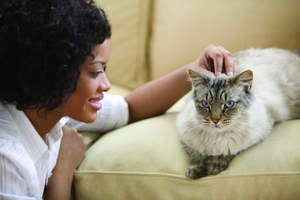MISSION, KS--(Marketwire - Apr 5, 2012) - (Family Features) When it comes to nutrition, people and their feline family members aren't so different. At every stage of development, a diet balanced with the right mix of specific vitamins and nutrients is important for good health and well-being. From kittens to mature cats, providing the proper nutrition at every life stage will help your pet thrive.
But finicky felines aren't always receptive when their old food is swapped for a new one. Dr. Jennifer Coates, veterinarian and author of petMD's "Nutrition Nuggets" blog, knows that introducing a new cat food can be difficult. To help owners provide the very best nutrition for their felines, Coates has teamed up with Hill's® Science Diet® to provide the following tips to help make the transition as smooth as possible:
Patience pays off. In order to successfully change your cat's diet, you must be patient and persistent. Your cat may resist at first, but good nutrition is one of the best ways to promote your cat's health and longevity, so don't let a few bumps in the road deter you from your goal.
Make a smooth transition. Try to avoid sudden switch-ups. A dramatic change in smell, flavor of texture can be difficult for cats to deal with. Gradually introduce the new food when possible. If you have to make an abrupt change because of a health concern, talk to your veterinarian about the best method to introduce the new food your cat needs.
Mix it up. Blend old and new foods together for at least five days. Start with approximately 90 percent of your cat's old food mixed thoroughly with 10 percent of the new food and gradually decrease the amount of the former and increase the amount of the latter for as long as is necessary.
Find a balance. Before switching your cat's diet, make sure you understand the proper balance of nutrients your feline needs to receive by using the new MyBowl tool at www.petMD.com. This free online tool allows you to understand the specific needs of your feline at every stage of development and illustrates the proper portion for essential foods such as proteins, carbohydrates, vitamins, minerals, fats and oils.
Look to quality cat foods. Well-balanced cat foods make it easy for cat parents to ensure their feline gets the nutrients they need. Look to products, such as Hill's® Science Diet® Ideal Balance™ for felines, which makes feeding your cat a balanced diet simple by incorporating all-natural ingredients formulated in precise amounts to provide the exact balance of nutrition your pet needs. With chicken listed as the key ingredient, this food also incorporates healthful fruits and vegetables and is formulated without corn or artificial colors, which can impair digestion.
Get creative. If your cat is resisting the change, try making warm gravy out of your cat's old food and pour it over the new diet. Simply mix a small amount of the old canned food or crushed-up kibble with a few tablespoons of hot tap water. The heat will activate the smells your cat is familiar with and they'll begin to eat the new food.
Visit the cat Nutrition Center on www.petMD.com, developed in partnership with Hill's® Science Diet®, to access educational tools and information about properly balanced cat nutrition.
About Family Features Editorial Syndicate
This and other food and lifestyle content can be found at www.editors.familyfeatures.com. Family Features is a leading provider of free food and lifestyle content for use in print and online publications. Register with no obligation to access a variety of formatted and unformatted features, accompanying photos, and automatically updating Web content solutions.
Contact Information:
Wendy MacDonald
wmacdonald@familyfeatures.com
1-888-824-3337 ext. 235
http://editors.familyfeatures.com
